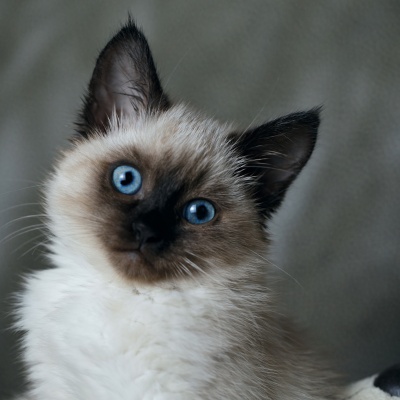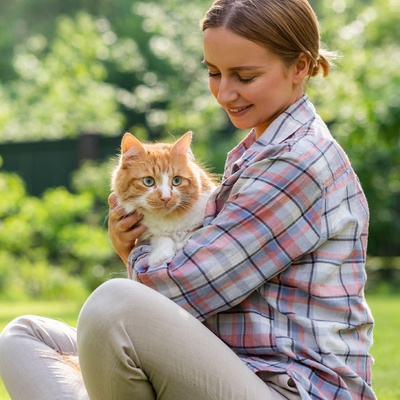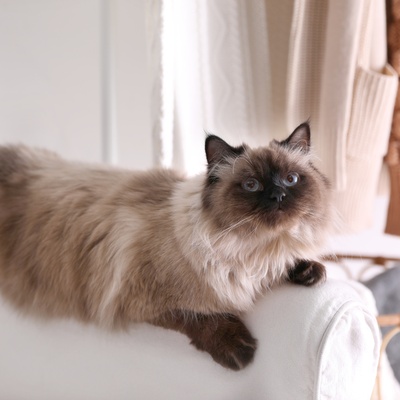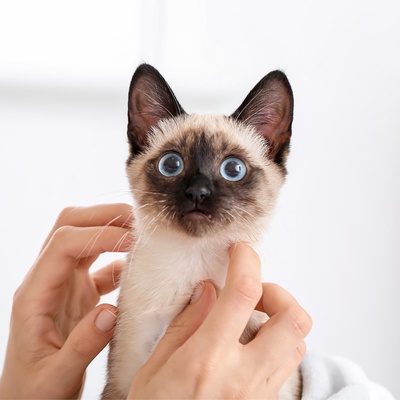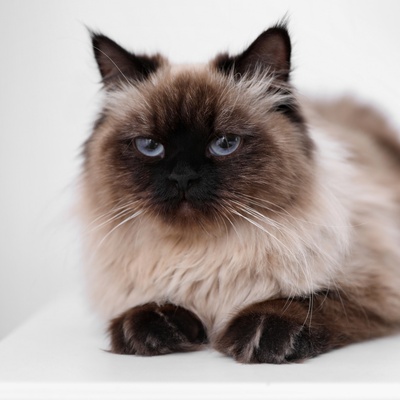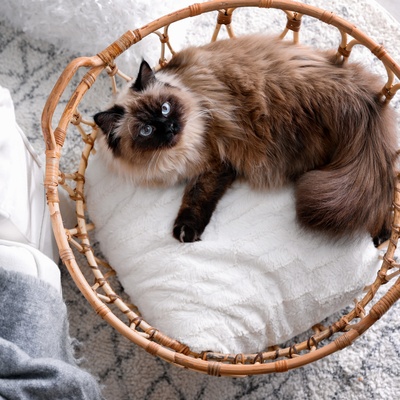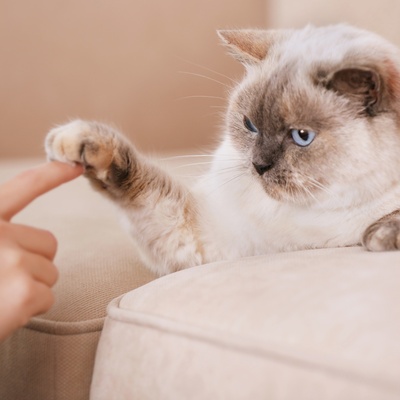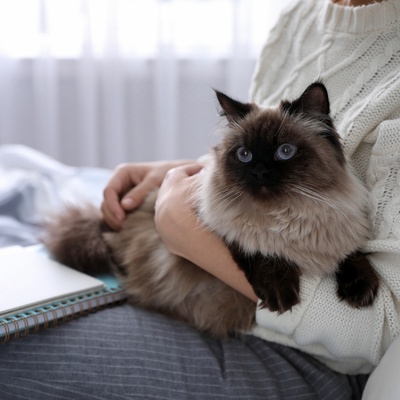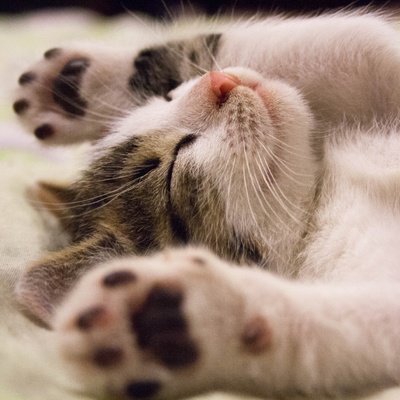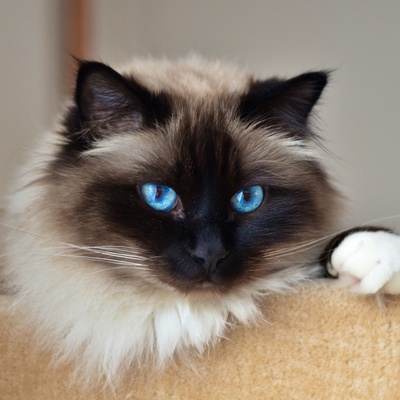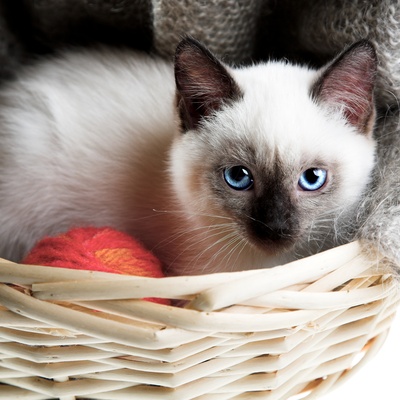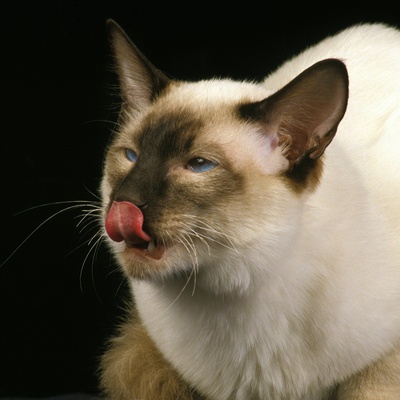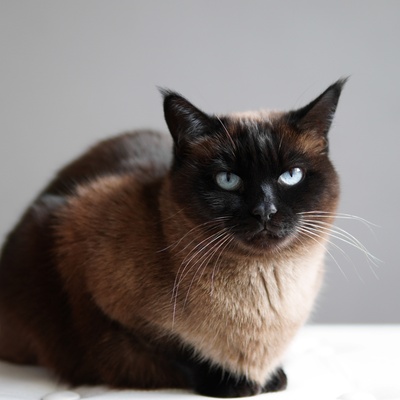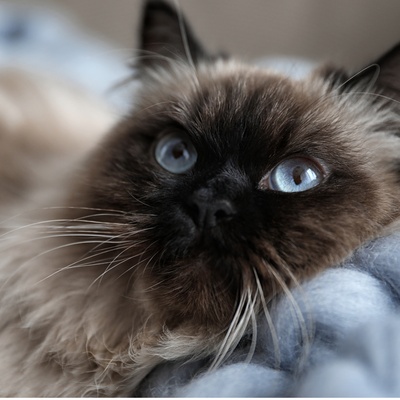Introducing the Balinese
Find out all you need to know about the Balinese: its characteristics, behaviour, education and price.

Find out all you need to know about the Balinese: its characteristics, behaviour, education and price.
The Balinese is a cat with undeniable charm. Originating in the United States, this breed is the result of a natural mutation in a litter of Siamese cats. This genetic heritage gives it a silky coat and elegant appearance. Highly intelligent and sociable by nature, the Balinese stands out for its lively, playful temperament.
They are very attached to their family environment, constantly seeking interaction and affection. Despite their energy, Balinese cats are gentle, peaceful companions.
This section outlines the unique features of the Balinese breed.
The Balinese is a medium-sized cat, generally measuring between 11.8 and 13.8 inches at the withers and weighing between 5.5 and 11 pounds.
The Balinese has a medium-length, silky coat with no undercoat, giving it an elegant, refined look.
Although not hypoallergenic, the Balinese is often tolerated by allergy sufferers thanks to its unique coat.
Balinese comes in a variety of colors, from blue to chocolate, lilac and seal point, often with distinct shaded nuances.
Balinese adapt well to different environments, whether apartment or house, as long as there's enough space to play and explore.
This breed is extremely sociable, enjoying the company of humans and getting on well with children and other animals.
Balinese are generally in good health, but can be prone to certain genetic conditions common to Oriental breeds, such as dental or heart problems.
The Balinese, known for its intelligence and sociability, is relatively easy to train, responding well to a gentle, patient approach to training.
We can help you!
Every cat has its own character and specific needs. Making the right choice will ensure his well-being and yours.
Thanks to our quiz, you'll know which breed is right for you, depending on your lifestyle, expectations and many other criteria.
Don't wait any longer and take the quiz to find out the answer!
The Balinese is distinguished mainly by its elegance and feline grace. Its slender stature and long, silky hair give it the appearance of a prima ballerina among felines.
The Balinese, with its fine, slender silhouette, is characterized by its medium size. They generally weigh between 5,5 and 11 inches, males being slightly heavier than females.
Growth is moderate, reaching adult size and weight at around 2 years of age. In addition to its modest size, the Balinese is distinguished by long, slender legs and a feathery tail, adding to its delicate, refined allure.
Balinese coats are medium-length, silky and flowing, characterized by fine hairs that cascade, giving an impression of lightness and constant movement.
The Balinese color palette varies, including shades from seal point to blue, chocolate and lilac, often accented by the characteristic darker markings of the points.
Although the Balinese doesn't shed much, weekly brushing is recommended to keep its coat silky and prevent tangles. This breed is not classified as hypoallergenic, but its unique coat may be better tolerated by some allergy sufferers.
The Balinese is distinguished by its slender, graceful silhouette, symbolizing elegance and suppleness. Their ears are large and pointed, continuing the line of their triangular face. His body is slender but muscular, with fine bones reflecting his natural agility.
His muzzle is fine and elegant, in harmony with the rest of his face. Its almond-shaped eyes can vary from deep blue to sapphire, adding to its mysterious charm. All these features underline the beauty and uniqueness of the Balinese.
Although the Balinese doesn't shed much, grooming involves regular brushing, ideally once a week, to keep the coat soft and shiny. During moulting periods, which can occur mainly in spring and autumn, it's advisable to increase brushing frequency.
Although baths are not often necessary thanks to their own grooming, an occasional bath with a suitable shampoo can be beneficial, especially to keep their mid-length coat in perfect condition.
The Balinese is a highly sensitive cat, both affectionate and communicative, making it an ideal companion for those seeking a close relationship with their pet.
The Balinese is renowned for its great sociability and deep attachment to humans. He quickly forges a strong bond with his master, often following him from room to room and constantly seeking his attention. He's both playful and cuddly, enjoying playtime as much as petting sessions.
His language is rich in purrs, meows and other expressive sounds, reflecting his need to interact and communicate. For owners looking for a cat that is both present and affectionate, the Balinese is a perfect choice.
The Balinese, with its gentle, sociable temperament, fits perfectly into a family, getting on well with children, other cats and even dogs.
They are patient and rarely aggressive, preferring to isolate themselves to calm down when overwhelmed or stressed. This breed is ideal for those looking for a calm, friendly cat that adapts well to family life.
Choosing a cat that matches your personality and lifestyle will ensure your well-being and his!
The Balinese is a remarkably adaptable cat, whether in an apartment or a house. It is essential, however, that its owner be present, as it needs constant companionship to thrive.
Although he can cope with small spaces, it's best to offer him a place to live where he can explore and play, as he's active and loves to exercise.
The Balinese is a naturally curious and playful cat, with a strong need for mental and physical stimulation. He appreciates interactive games, play sessions with his owner, and spaces where he can climb and explore.
A stimulating and engaging environment is crucial to his well-being, as boredom can lead to destructive behavior. It's also important to offer him peaceful corners where he can rest and recharge his batteries.
Education must start at an early age to establish positive behaviors and avoid future problems. An education based on benevolence, reward and consistency is essential.
He is receptive to learning through play, which stimulates his intelligence and helps prevent undesirable behavior. Consistency and patience are key to successful training, enabling good behaviors to be reinforced right from the start.
The Balinese, renowned for its well-balanced character, is also appreciated for its sturdiness and general good health, with no breed-specific health problems.
On the whole, the Balinese is a healthy cat, rarely prone to serious illness. However, as with many breeds of cat, they may be predisposed to certain hereditary diseases, such as hypertrophic cardiomyopathy, a heart disease, and less frequently, polycystic kidney disease.
DNA testing can be an effective way of detecting these conditions and preventing their transmission. Regular veterinary check-ups to vaccinate against common diseases such as coryza, typhus and rabies are crucial to ensure a long and healthy life for your Balinese.
The Balinese, known for its slender, elegant figure, requires a quality diet to maintain its physical shape and good health. Highly nutritious kibbles should form the basis of his diet, complemented by fresh foods such as green vegetables rich in water, promoting kidney health and good hydration.
The Balinese reaches physical maturity around the age of 2. We recommend keeping a constant brand of kibble to ensure a stable diet, and serving his meals at regular times to preserve the balance of his digestive system.
Although the Balinese is naturally active and playful, a poorly controlled diet can lead to weight gain. Encouraging regular exercise, through games, runs and jumping sessions, is crucial to maintaining ideal weight and promoting good health. Playful interaction with the owner also strengthens the emotional bond while providing the stimulation necessary for his physical and mental well-being.
The Balinese, with its natural elegance and affectionate character, is a sought-after breed. It's important to consider a few factors before adopting a Balinese.
Adopting a Balinese should be done through professional breeders or specialized catteries. It's essential to visit the cattery to observe the cats' living conditions.
It’s also important to check for health examinations and DNA tests conducted on the kitten and its parents to identify any potential hereditary health issues.
Lastly, mandatory electronic identification, like microchipping, is not always mandated at the federal level in the United States for cats and dogs. But microchipping is widely acknowledged as a successful way to permanently identify pets and increase the possibility of reuniting lost pets with their owners, even in the absence of universal regulations.
As a pet owner, it is advised to inform yourself about municipal laws to ensure the safety and wellbeing of your pet.
The purchase price of a Balinese varies according to several criteria, such as lineage, pedigree, age and the breeder's reputation. In general, the price of a Balinese kitten ranges from
and
It's also important to consider annual maintenance costs, including food, veterinary care and accessories, which can range from
to
per year. Adopting a Balinese is a long-term commitment, requiring careful thought to ensure its well-being throughout its life.
Choosing a cat that matches your personality and lifestyle will ensure your well-being and his!
